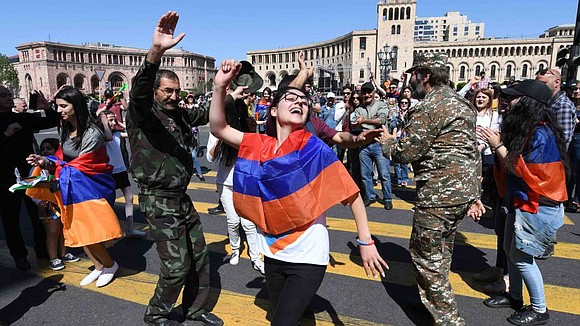Protests in Armenia after opposition leader's power bid blocked
CNN/Stylemagazine.com Newswire | 5/2/2018, 7:27 a.m.
By Sheena McKenzie Gianluca Mezzofiore, CNN
(CNN) -- Armenia's capital Yerevan was brought to a standstill on Wednesday as thousands of demonstrators blocked roads and danced in the streets, after parliament refused to elect their protest leader as the new prime minister.
Supporters of Nikol Pashinyan heeded his call for a nationwide day of action, blocking roads leading to Yerevan's main airport, and forcing some passengers to leave their cars and continue to the terminals on foot.
Protesters also blocked roads to government buildings, including the Ministry of Defense, demonstrator Marina Gasparyan told CNN.
Pashinyan, 42, lost a parliamentary vote on Tuesday to become interim prime minister. The vote followed the resignation last week of former prime minister Serzh Sargsyan, who was forced to step down amid weeks of mass demonstrations, led by Pashinyan's movement.
But Pashinyan's bid to become the new prime minister was thwarted by the Republican party, which holds a majority in parliament and is allied to Sargsyan, after nine hours of bad-tempered debate. After losing the vote, Pashinyan called for protests on Wednesday.
"I'd say 96% of Yerevan streets are blocked by protesters. Streets are closed mainly by cars," Marina Gasparyan, the demonstrator, told CNN, adding that many protesters were communicating using the messaging app Telegram.
The protests appeared to be largely peaceful, with local residents giving out strawberries and water to the demonstrators, according to Gasparyan.
Elsewhere, demonstrators were pictured dancing in the streets.
Protester and investment analyst, Emin Ohanjanyan, told CNN that the demonstrations had so far been very peaceful.
"I think the protest will continue because now even government employees are with the protesters," he said, adding, "I think it will be resolved in a week."
Pashinyan, a former journalist and leader of the opposition Civil Contract party, will face a second round of parliamentary votes next week. If it again fails to choose an interim prime minister, there must be new elections.
With his trademark black cap and camouflage T-shirt, Pashinyan has cut a rebellious figure throughout the protests.
His rough-and-ready style was in stark contrast to the suited former prime minister Sargsyan, and during a televised meeting last month -- which the prime minister walked out of -- Pashinyan even appeared with a bandaged hand which he reportedly injured on barbed wire.
Explainer: What's happening in Armenia?
How did we get here?
Protests began in mid-April after Sargsyan was appointed Prime Minister. Sargsyan had previously served as Armenian president for 10 years, and the thousands of protesters who hit the streets of Yerevan saw his latest appointment as an unconstitutional power grab.
Under constitutional changes Sargsyan promoted in 2015, the prime minister became more powerful than the president, leading to concerns of authoritarian rule descending on the small former Soviet republic, which borders Azerbaijan, Turkey, Iran and Georgia.
As the protests entered their 11th day, Sargsyan stepped down as Prime Minister. His deputy, Karen Karapetyan, was then named acting Prime Minister at an emergency Cabinet meeting.
But according to Laurence Broers, an associate fellow at the Chatham House think tank's Russia and Eurasia program, discontent with Sargsyan had been brewing for years.
Armenians have seen their country, once the poster child for democratization after the collapse of the Soviet Union, stagnate in the hands of an entrenched oligarchy while many citizens choose to leave, Broers said.
Broers doesn't ascribe sole credit to Pashinyan for the latest protests, but said the opposition figure "has been very successful in harnessing that desire and that energy for change."
What's Russia got to do with it?
Russia is likely to be watching the outcome of it's former Soviet republic closely -- the countries maintain close relations, with Moscow also an important provider of military hardware to Yerevan.
While Russia does not share a border with Armenia, it wields serious regional influence. When fighting broke out in 2016 between Azerbaijan and the Armenia-backed region of Nagorno-Karabakh, the Russian government quickly brokered a ceasefire.
But the Kremlin is also suspicious of what Russian officials describe as "colored revolutions" -- democratic uprisings that have led to the ouster of friendly governments in Ukraine, Georgia and elsewhere -- as well as opposition demonstrations at home.
So far, Pashinyan has focused his criticism on domestic issues, rather than relations with Russia. How that would play out were he to be elected prime minister, is yet to be seen.




